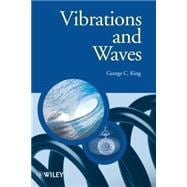
What is included with this book?
Author’s Preface.
1 SIMPLE HARMONIC MOTION.
1.1 Physical Characteristics of Simple Harmonic Oscillators.
1.2 A Mass on a Spring.
1.2.1 A mass on a horizontal spring.
1.2.2 A mass on a vertical spring.
1.2.3 Displacement, velocity and acceleration in simple harmonic motion.
1.2.4 General solutions for simple harmonic motion and the phase angle φ.
1.2.5 The energy of a simple harmonic oscillator.
1.2.6 The physics of small vibrations.
1.3 The Pendulum.
1.3.1 The simple pendulum.
1.3.2 The energy of a simple pendulum.
1.3.3 The physical pendulum.
1.3.4 Numerical solution of simple harmonic motion3.
1.4 Oscillations in Electrical Circuits: Similarities in Physics.
1.4.1 The LC circuit.
1.4.2 Similarities in physics.
PROBLEMS 1.
2 THE DAMPED HARMONIC OSCILLATOR.
2.1 Physical Characteristics of the Damped Harmonic Oscillator.
2.2 The Equation of Motion for a Damped Harmonic Oscillator.
2.2.1 Light damping.
2.2.2 Heavy damping.
2.2.3 Critical damping.
2.3 Rate of Energy Loss in a Damped Harmonic Oscillator.
2.3.1 The quality factor Q of a damped harmonic oscillator.
2.4 Damped Electrical Oscillations.
PROBLEMS 2.
3 FORCED OSCILLATIONS.
3.1 Physical Characteristics of Forced Harmonic Motion.
3.2 The Equation of Motion of a Forced Harmonic Oscillator.
3.2.1 Undamped forced oscillations.
3.2.2 Forced oscillations with damping.
3.3 Power Absorbed During Forced Oscillations.
3.4 Resonance in Electrical Circuits.
3.5 Transient Phenomena.
3.6 The Complex Representation of Oscillatory Motion.
3.6.1 Complex numbers.
3.6.2 The use of complex numbers to represent physical quantities.
3.6.3 Use of the complex representation for forced oscillations with damping.
PROBLEMS 3.
4 COUPLED OSCILLATORS.
4.1 Physical Characteristics of Coupled Oscillators.
4.2 Normal Modes of Oscillation.
4.3 Superposition of Normal Modes.
4.4 Oscillating Masses Coupled by Springs.
4.5 Forced Oscillations of Coupled Oscillators.
4.6 Transverse Oscillations.
PROBLEMS 4.
5 TRAVELLING WAVES.
5.1 Physical Characteristics of Waves.
5.2 Travelling Waves.
5.2.1 Travelling sinusoidal waves.
5.3 The Wave Equation.
5.4 The Equation of a Vibrating String.
5.5 The Energy in a Wave.
5.6 The Transport of Energy by a Wave.
5.7 Waves at Discontinuities.
5.8 Waves in Two and Three Dimensions.
5.8.1 Waves of circular or spherical symmetry.
PROBLEMS 5.
6 STANDING WAVES.
6.1 Standing Waves on a String.
6.2 Standing Waves as the Superposition of Two Travelling Waves.
6.3 The Energy in a Standing Wave.
6.4 Standing Waves as Normal Modes of a Vibrating String.
6.4.1 The superposition principle.
6.4.2 The superposition of normal modes.
6.4.3 The amplitudes of normal modes and Fourier analysis.
6.4.4 The energy of vibration of a string.
PROBLEMS 6.
7 INTERFERENCE AND DIFFRACTION OF WAVES.
7.1 Interference and Huygen’s Principle.
7.1.1 Young’s double-slit experiment.
7.1.2 Michelson spectral interferometer.
7.2 Diffraction.
7.2.1 Diffraction at a single slit.
7.2.2 Circular apertures and angular resolving power.
7.2.3 Double slits of finite width.
PROBLEMS 7.
8 THE DISPERSION OF WAVES.
8.1 The Superposition of Waves in Non-Dispersive Media.
8.1.1 Beats.
8.1.2 Amplitude modulation of a radio wave.
8.2 The Dispersion of Waves.
8.2.1 Phase and group velocities.
8.3 The Dispersion Relation.
8.4 Wave Packets.
8.4.1 Formation of a wave packet.
PROBLEMS 8.
APPENDIX: SOLUTIONS TO PROBLEMS.
Index.
The New copy of this book will include any supplemental materials advertised. Please check the title of the book to determine if it should include any access cards, study guides, lab manuals, CDs, etc.
The Used, Rental and eBook copies of this book are not guaranteed to include any supplemental materials. Typically, only the book itself is included. This is true even if the title states it includes any access cards, study guides, lab manuals, CDs, etc.